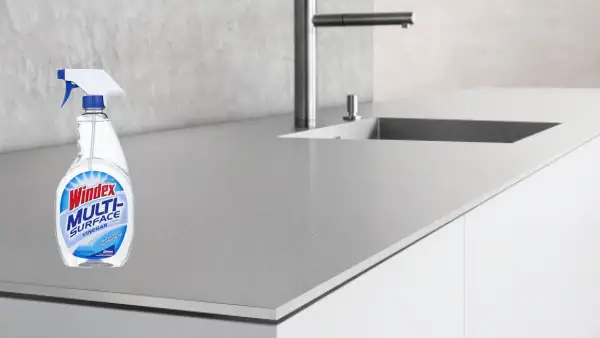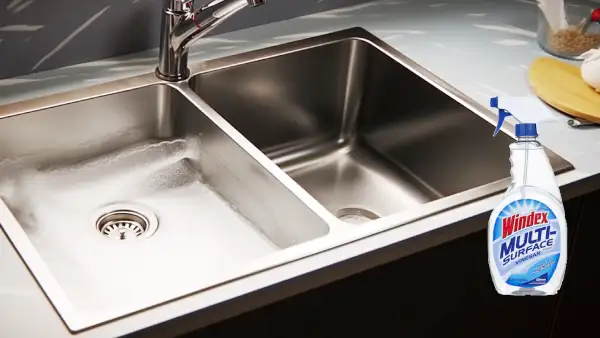Last Updated on November 14, 2023
Stainless steel surfaces are widely used because of their sleek and elegant appearance. But they need regular cleaning with the right products to maintain their luster and prevent damage. So, you may wonder if Windex can be used on Stainless Steel surfaces.
You can definitely use Ammonia-Free Windex on your stainless steel surfaces in the kitchen or other places to achieve a streak-free shine. This cleaner is designed to clean and disinfect hard, non-porous stainless steel surfaces effectively.
This cleaner can kill 99.9% of germs and bacteria when used as directed. To ensure the best results, you should follow a few key steps. As part of this article, we will discuss these steps for using Windex on stainless steel. So keep reading to make your surfaces shine with confidence.
How Do You Use Windex Ammonia-Free Cleaner on Stainless Steel Surfaces?

To clean your stainless steel kitchen surfaces with Windex Ammonia-Free cleaner, follow these steps carefully:
- Check for manufacturer’s instructions
- Dust or remove loose debris
- Spray Windex ammonia-free cleaner
- Wipe with a microfiber cloth
- Repeat if necessary
- Final polish (optional)
Materials You’ll Need:
- Windex Ammonia-Free cleaner
- Microfiber cloth or a soft, lint-free cloth
- Warm water (optional)
STEP 1. Check for Manufacturer’s Instructions
Before cleaning a stainless steel appliance or surface, check if the manufacturer has provided any specific instructions. These instructions are important because they’re tailored to your stainless steel’s specific material and finish, ensuring you clean it safely and effectively.
STEP 2. Dust or Remove Loose Debris
Now, lightly wipe away any loose dirt or debris from the stainless steel surface with a dry cloth or paper towel before applying the cleaner. Removing loose dirt or debris creates a clean canvas for the Windex to work effectively.
STEP 3. Spray Windex Ammonia-Free Cleaner
After wiping away the loose dirt or debris, you can proceed to spray the Windex on the stainless steel surface. Make sure to follow the directions on the bottle and use a clean cloth to wipe the surface in a gentle, circular motion.
Cover the entire area when spraying, focusing on any greasy or dirty spots. Allow the cleaner to sit for a few moments, allowing it to penetrate and break down any grime. Then, using a soft cloth or microfiber towel, wipe the surface toward the grain, removing any dirt and leaving a shiny, streak-free finish.
STEP 4. Wipe with a Microfiber Cloth
You can now easily wipe the stainless steel surface with a microfiber cloth, effectively removing dirt or grime. A microfiber or soft, lint-free cloth is crucial when cleaning stainless steel to prevent scratches or damage.
Make sure to wipe in the direction of the grain, which is typically a series of faint lines or striations on the surface. This helps to avoid leaving streaks or smudges. Apply gentle pressure while wiping and, if needed, use a bit of elbow grease to tackle stubborn stains or spots.
STEP 5. Repeat If Necessary
While there may not be specific indications, you should continue cleaning with Windex cleaner until the stains are fully gone. The key is to be thorough and persistent in your cleaning efforts.
Apply a bit more cleaner and use a microfiber cloth to wipe the surface. Keep repeating this process until all the stains are completely removed.
STEP 6. Final Polish (optional)
To achieve a polished finish, apply a small amount of Cerama Bryte or PARKER & BAILEY stainless steel polish and buff it in circular motions using a soft cloth. After buffing, you’ll notice a shiny and clean stainless steel surface.
Is Windex safe to use on stainless steel?
Windex is generally considered safe for use on stainless steel, but be sure to follow the directions and guidelines provided by the manufacturer. When cleaning your stainless steel kitchen sink, use an ammonia-free cleaner and go with the grain to avoid scratching the surface.
Can I use Windex on all types of stainless steel surfaces?
You can safely use Windex on most stainless steel surfaces. Windex is an effective cleaner for removing fingerprints, smudges, and other surface stains from stainless steel. Its potent formula helps to dissolve grease and dirt, leaving your stainless steel surfaces clean and shiny.
Use Windex to clean the stainless steel exteriors of their refrigerators and dishwashers, which can show fingerprints and smudges easily. But there are also smaller glass surfaces in your kitchen that you can touch up with Windex, such as the oven door, microwave exterior, or glass cabinets.
However, note that some stainless steel products may have a protective coating or specific cleaning recommendations from the manufacturer. To ensure you don’t damage the surface, use ammonia-free Windex cleaner.
Is Windex able to shine stainless steel?

A bottle of Windex can work wonders on stainless steel appliances and other surfaces. Windex is a versatile cleaner that can cut through grease and grime, leaving behind a streak-free shine.
To use it on stainless steel, simply spray a small amount onto a soft cloth and wipe down the surface toward the grain. With just a few quick sprays and wipes, your stainless steel surfaces can look as good as new.
Does Windex leave a residue on stainless steel surfaces?
Windex won’t leave a noticeable residue on stainless steel surfaces when used as directed and properly wiped. It’s designed to provide a streak-free shine. If you want the best results, following the instructions on the bottle and using a clean, lint-free cloth or microfiber towel to wipe the surface is important.
To avoid overspray and potential residue, spray a small amount of Windex onto the cloth rather than directly onto the stainless steel. Then, gently wipe the surface in a circular motion, covering the entire area. Finally, use a dry cloth to buff the surface and remove excess moisture.
Achieve a spotless and gleaming kitchen with Windex Ammonia-Free Cleaner
The Windex Ammonia-Free Cleaner is an effective and reliable cleaning product for sanitizing and washing stainless steel surfaces in your kitchen. Ensure you follow the proper cleaning procedures and use the right tools and products to avoid damage and maintain your surfaces’ shine.
Read the manufacturer’s instructions, remove debris or dust, apply Windex Ammonia-Free cleaner in moderation, and wipe in the direction of the metal grain. Don’t hesitate to try it out for yourself and enjoy the shine of your stainless steel.
